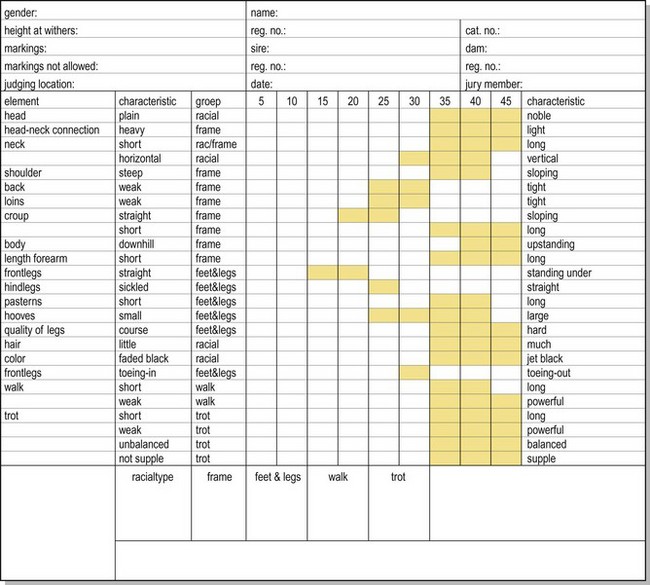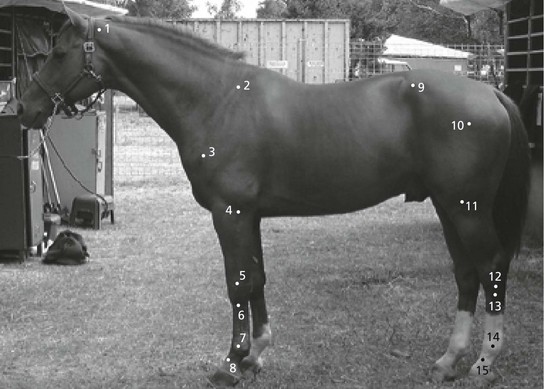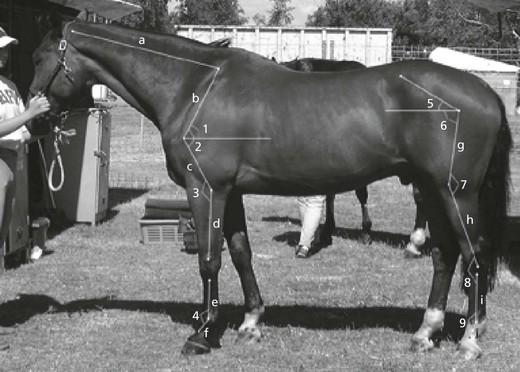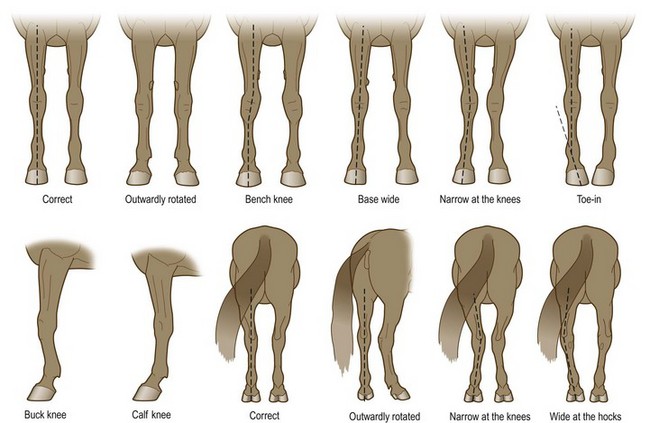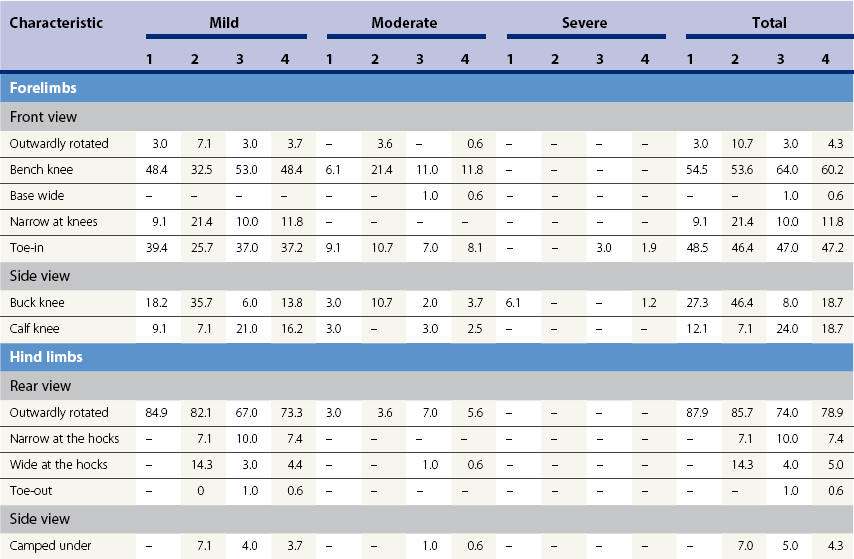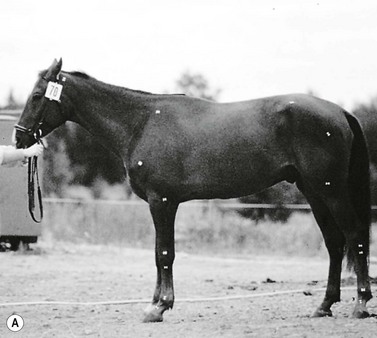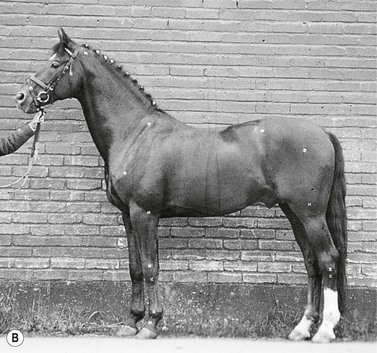Chapter 11 For as long as the horse has been used by man, conformation has been regarded as an important indicator of performance and soundness. In accordance with the variety of uses, many different types and breeds of horses have evolved, ranging from heavy draught horses to light, refined racehorses. The result is that a huge number of breeds exist today, each with its own specific conformational characteristics. Nevertheless, conformational traits are not always a guarantee for performance and soundness. The effects of conformation on lameness and athletic potential have mostly been evaluated subjectively and based on anecdotal evidence and experience of the observer (Van Weeren & Crevier-Denoix, 2006). Some people would consider this an ‘art form’ in which some people have a natural talent for assessing the influence of different conformational characteristics on injury and talent. This chapter will focus on conformational characteristics that, subjectively or objectively evaluated, are considered important for the performance and soundness of the sport horse and the racehorse. Much has been written about the conformation of the horse during the past 200 years, but very little is based on research. This does not mean that the work is of less interest. It is thought provoking that many of the relationships between conformation and performance described by Bourgelat (1750) and Magne (1866) correspond well with the results from recent research. They stressed the importance of the hindquarter conformation. Horses with hind limbs placed well underneath themselves were found suitable for dressage work, whereas those with hind limbs camped out behind were likely to show good speed. Another early author, Hörman (1837), wrote that a long and forwardly sloping femur facilitates lifting of the hind limb and the horse’s ability to step under itself. Ehrengranat (1818) maintained that a sloping shoulder, long radius, short fore cannon and a flat croup are desirable for good movement. According to Schmidt (1928), a small hock angle means that, although the horse will be able to step under itself easily, it will not be able to carry weight on the hind quarters due to decreased strength in the hock. Thus, he regarded a normal hock angle as advantageous for the function of the hind limbs. Most authors of handbooks on conformation evaluation believe that a large hock angle leads to rigid and incorrect hind limb movements as well as an increased strain on the hind limb joints (Wrangel, 1911–1913; Forsell, 1927; Anon, 1940; Bengtsson, 1983). Much of these horsemen’s knowledge is still in practice but parts of it seem to have been forgotten in recent years. Traditional subjective evaluation of conformation is currently performed in many different ways. Almost every country has its own protocol. Furthermore, many breeds have their own specific regulations that instruct the judges how to judge according to the standards of the breed. A problem with traditional evaluation is that subjective evaluations of conformation vary greatly between judges, although some morphological characteristics are assessed more consistently than others (van Vleck & Albrechtsen, 1965; Grundler, 1980; Magnusson, 1985a; Van der Veen, 1996). It is obvious that the reliability of the evaluation is dependent on the skill and experience of the individual judge. A step towards a more objective interpretation and analysis of subjectively obtained conformation scores is the so-called linear scoring system, in which trained members of the jury score the conformation of the horse relative to the mean of the population (Van der Veen, 1996). Thus, judging still remains subjective, but it is the interpretation and the analysis of the judges’ scores that becomes more objective. In the Netherlands this is done for the Warmblood (KWPN) as well as the Friesian (KFPS) horses at studbook admission (Fig. 11.1). Quantitative methods for measuring conformation can be used for an objective evaluation (Rossdale & Butterfield, 2006). Several studies have been carried out, especially on riding horses. The results do often show a great deal of conformity, but in most cases it is impossible to directly compare such parameters as angle measurements from different studies, due to differences in methods of measurement. Quantitative conformational analysis, as a complement to the traditional evaluation, has been proven to increase the accuracy in the prediction of performance potential in young riding horses (Holmström & Philipsson, 1993). However, applying this knowledge in practice, i.e. in breeding evaluation programs, talent scouting, etc., has been very difficult. Much of the resistance to quantitative analysis is due to the deeply rooted tradition of subjective evaluations in the horse industry, combined with a lack of familiarity with the new methods. In addition, there are some shortcomings in the method itself. Obtaining quantitative measurements has, until recently, been a slow procedure – too slow to be incorporated into stallion tests and other similar events. New computerized methods have now been developed that will speed up the process and make it possible to measure many horses in a short time. In recent years an objective method, developed in Sweden by Magnusson (1985a) for a study of Standardbred trotters, has been further developed and refined for use in the Thoroughbred racehorse industry in the USA (M Holmstrom and D Lambert, unpublished work, 2004). The method was originally based on reference points marked on the horse with small paper dots glued to the skin (Fig. 11.2), and when first used all measurements were registered ‘by hand’ from a picture projected on a wall using a simple measuring band and a protractor. Later the whole procedure was computerized and the measurements were obtained from a digital photo on a laptop computer. The measurements were registered by clicking with the mouse on the white markers. The computer then calculates all length and angle measurements (Fig. 11.3). In the most recent version joint angles and length and proportional measurements can be obtained from a picture with just one paper dot on the hip. One important part of the subjective evaluation is to describe deviations of limb and toe axes, if any. The most common deviations are described in Figure 11.4. Deviations from the straight (normal) limb and toe axes have traditionally been considered as a considerable weakness. However, not all deviations from what has been the desired conformation should be judged as abnormal. About 80% of all Warmblood riding horses and Standardbred trotters had outwardly rotated hind limbs (Magnusson, 1985a; Holmström et al., 1990). The frequency of this ‘faulty conformation’ is so high that it must be regarded as normal. Boldt (1978) maintains in his dressage handbook that outwardly rotated hind limbs facilitate exercises such as half-pass and shoulder-in. In this context, it is important to distinguish between hind limb rotation and toe-out conformation as well as between rotated hind limbs and hind limbs that are narrow at the hocks (cow hocked). Confusion between these characteristics should be avoided, especially as the rotated hind limb conformation should be considered normal. To judge this aspect of conformation, the observer should stand behind the point of the hock rather than behind the tail of the horse. The latter position makes it impossible to see if the rotated hind limb is also narrow at the hocks. Bench kneed conformation in the forelimbs together with a toe-in conformation is a very common type of deviation in riding horses, while outwardly rotated forelimbs are seldom seen in adult riding horses (Holmström et al., 1990). According to Magnusson and Thafvelin (1985a) the converse is the case in Standardbred trotters. This difference may partly be explained by the fact that trotters are narrower through the chest than the riding horses, even after adjustment for different height at the withers. Several other authors have also found that bench knee and toe-in conformation seems to be related to weight and width of the breast (Santschi et al., 2006; Firth et al., 1998). Santschi et al. (2006) studied the development of front limb deviations in foals and concluded that calf knee conformation in foals tends to self correct and eventually and it was also found that the incidence of bench knee increased between the age of 1 week and 18 months. Anderson et al. (2004) compared conformation to injury in Thoroughbreds and found that calf knees were somewhat protective agains injuries. Today most clinicians feel that mild carpal valgus is protective and is actually normal during growth. As in the hind limbs, there is often confusion between outwardly rotated forelimbs and a toe-out conformation. Even though bench knee conformation in a riding horse does not have any documented negative effects on the long-term performance, bench kneed horses have been reported to have a higher frequency of splints on the medial side of the third metacarpal bone (Adams, 1974; Davidson, 1970; Nordin, 1980). The frequency of toe-in and/or bench knee conformation, as well as of most other deviations, was the same among the elite dressage horses and show jumpers as in a group of riding school horses (Table 11.1). This indicates that mild-to-moderate deviations from the ‘normal’ limb conformation do not impair either soundness or performance in riding horses. However, it is important to emphasize that, even though mild and moderate deviations can be accepted, severe deviations of any type should be considered as a major weakness. Several authors have claimed that there is an increased stress to the distal parts of the limbs in horses with toe-out and toe-in conformation (Churchill, 1962; Rooney, 1968; Beeman, 1973; Magnusson, 1985c). This can often be noticed as synovial distensions of the fetlock and the coffin joints, as well as swelling of the distal metacarpal growth plate. According to Adams (1974), calf knee (back at the knee) conformation may predispose to lameness, whereas buck knee (over at the knee) conformation is less serious. This is probably true for Standardbreds as well as Thoroughbred racehorses that overextend the carpal joint considerably during the midstance phase. Steel et al. (2006) reported that carpal lameness occurred in 28% of a group of Standardbred horses and was present in 56% with forelimb lameness. Of the variables studied, poor forelimb conformation and more intense speed training were predisposing factors. Back et al. (1996) proved in Warmbloods that there is a relationship between a calf knee conformation at square stance and carpal hyperextension at trot. Many of the criteria that are used to describe the head, neck and body are very difficult or impossible to analyze objectively. Such criteria are type, the setting of the neck, the shape of the withers, the ‘harmony’ of the horse, etc. They have to be evaluated subjectively. Other characteristics, such as length of the neck and body or height at the withers, can be objectively measured or subjectively scored (Van der Veen, 1996). It is obvious that there are significant relationships between head, neck and body characteristics and performance, which are reflected in the difference between, for example, a slow, heavy draught horse and a fast, elegant racehorse. Thus, differences between breeds have, to a large extent, originated from different demands upon the horses. However, within a certain breed it is much more difficult to correctly describe and evaluate the relatively subtle differences, and this difficulty has been associated with a rather large variation between judges (van Vleck & Albrechtsen, 1965; Grundler, 1980; Magnusson, 1985a). Long experience, a deep understanding of the influence of conformation on performance and, when appropriate, inclusion of objective measurements can minimize these discrepancies. Figure 11.5 shows two horses, one with a low set neck and the other with a well set neck. In handbooks on evaluation of the conformation of sport horses, some characteristics are described more consistently. A long and well-set neck are considered important for most kinds of performances (Wrangel, 1911–1913; Forsell, 1927; Anon, 1940; Boldt, 1978; Bengtsson, 1983) and a long well-developed withers is said to be important for horses that are working under saddle (Van der Veen, 1996). In a large, cohort study of a Warmblood population, in which linear scoring results collected at studbook admission were related to later performance in dressage and show jumping, it appeared that when horses were genetically selected on height at the withers, neck length was shorter. Longer necks were genetically related to a conformation more suited for dressage performance but had less impact on jumping performance (Ducro et al., 2009a). In contrast, results from objective studies show that elite show jumpers have significantly longer necks than elite dressage horses and ‘normal’ horses (Holmström, unpublished data) (Table 11.2). Other studies showed significantly shorter necks in elite dressage horses than in other riding horses but there was no significant correlation between the length of the neck and gaits under saddle in 4-year-old riding horses (Holmström et al., 1990; Holmström & Philipsson, 1993). Available objectively obtained results indicate that a long neck might be an advantage for jumping horses, probably because it makes it easier for the horse to maintain balance over the fence. In dressage horses, the setting of the neck is probably more important than its length (Van der Veen, 1996). It is generally agreed among riders and trainers of riding horses that a low set neck makes it very difficult to work the horse in a proper frame. However, there are no data supporting this statement, mainly because of the difficulties of objectively measuring the setting of the neck. Table 11.2 Comparison of adjusted means for length and angle measurements* Values with different superscripts differ significantly from each other. *Between elite dressage horses (n = 40), elite show jumpers (n = 51), 4-year-olds tested at quality events (n = 217) and horses with back problems or recurrent lameness problems (n = 52). Differences in sex, and, for the stifle angle, differences in femur inclination, have been taken into consideration. The setting of the head to the neck is also of importance (Van der Veen, 1996). A wide throat latch has always been considered important in racehorses, Standardbred trotters and Quarter Horses because it is said to facilitate breathing. In dressage horses, a wide distance between the wing of the atlas (first cervical vertebra) and the posterior ridge of the mandible has been considered important by riders. In a study of differences between elite dressage horses, elite jumping horses and ‘normal’ horses it was found that both the dressage horses and the jumpers had significantly greater width in this area than other horses (Holmström, unpublished data). A possible explanation is that a small distance might cause problems, most likely a mechanical resistance, at higher levels of collection when the horse is required to perform a maximal flexion at the poll. Height at the withers has been linked to jumping performance in several studies (Neisser, 1976; Langlois et al., 1978). Müller and Schwark (1979) found that show jumpers were taller at the withers than dressage horses. Even though there is a positive correlation between height at the withers and jumping performance up to a certain limit (around 172 cm), it must be remembered that there is a great variation among elite show jumpers. The range of the height at the withers was between 158 cm and 178 cm in a study of the World Cup finalists in 1997 (Holmström, unpublished data). According to Ducro et al. (2009a) height at the withers was genetically related to dressage ranking but not to jumping ranking. It is generally agreed that height at the withers is not related to stride length in different gaits (von Wagener, 1934; Krüger, 1957; Dušek et al., 1970; Dušek, 1974). However, Holmström and Philipsson (1993)
The effects of conformation
Introduction
The study of equine conformation
History and tradition
Subjective evaluation
Quantitative analysis
Deviations of limb and toe axis
Head, neck and body
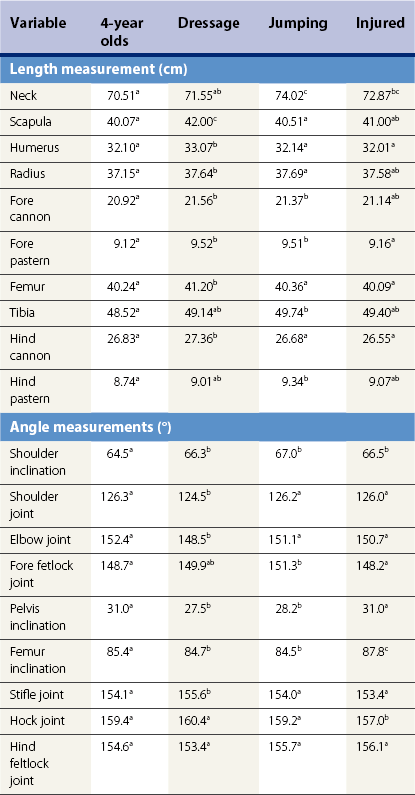
![]()
Stay updated, free articles. Join our Telegram channel

Full access? Get Clinical Tree


The effects of conformation

